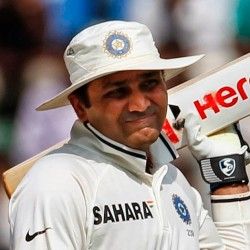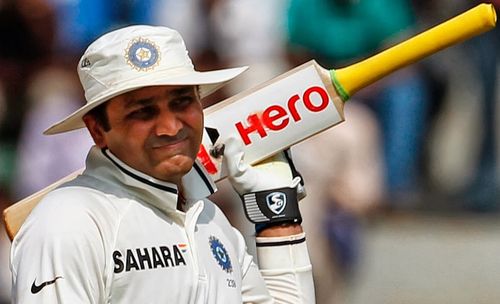
Virender Sehwag - An opener like no other

Virender Sehwag
‘Chak De, O Chak De India’ was the song that was being played in Wankhede that day as the two legends walked towards the 22-yard-strip. One of the jersey numbers was 10, while his dead ringer bore no number. The song fades away and the crowd cheer sinks in. The first ball from Malinga was played off the back foot straight to short cover; ball meeting the middle of the willow. Commentators praise him. The next ball, he was caught in front of middle and leg, and umpire Aleem Dar’s forefinger rose instantly. Malinga roared and the Lankans celebrated.
Every Indian’s heart was in his mouth for the next 4 minutes as Viru opted for a review. We all knew it was a plumb, but somewhere deep within we were expecting an overstep by Malinga; or the ball to miss the leg stump; or to go over the stumps, as no Indian wants Sehwag out.
His mantra is simple: ‘Ball is there to be hit, and I will hit it’. His strike rate in Tests is 82.23, highest by any cricketer in the history of Test cricket. He is the only Indian to have two Triple centuries in Tests. He is also the highest scorer in the ODI format. He shares the record for the most number of double centuries in Tests for India with his idol, Sachin Tendulkar. If I jot down all the records that this lad has conquered, it will be a never ending essay. His career is a cock-and-bull story. Popularly referred to as ‘Nawab of Najafgarh’, he is unanimously the best opener this country has ever produced. He is also probably the most feared batsmen alongside Chris Gayle, Sanath Jayasurya and Adam Gilchrist.
One thing that strikes your mind when someone talks about Sehwag is his footwork: completely unorthodox. His cuts, drives, and pulls early in the innings increased our heartbeats. Eight out of ten times, he would get out after hitting a boundary. His tendency of getting carried away never deserted him. In the pre-Kohli era, every time India chased – be it a Test match or an ODI – we rested our hopes on his shoulders.
He was reluctant when Ganguly asked him to open for India in Tests, as the middle order had too many big names. Sehwag’s reply was canny, ‘If I fail“, he is said to have told his skipper, “Promise me I won’t be forgotten. When a spot opens up, you will find me a place in the middle order”. Ever since, he has grown from rags to riches. A decade later, he is named in the Indian Test Dream XI and also the World Test Dream XI.
2007 was a year of mixed feelings for Sehwag. India was touring Australia under Anil Kumble’s captaincy, and Sehwag had been omitted from the list of probables. The then captain played Devil’s advocate, and his word was weighed above all as Sehwag toured Australia. He was benched for the first two Tests, both of which India lost. He made his way back to the team after hitting a brisk century in the practice match.
He played a vital role in the victory at Perth, hitting a blitzkrieg 72 and picking two wickets in the second innings. But the best Innings of his life was yet to come. In Adelaide Oval, we saw a different Sehwag: even tempered, composed and stoical. He laboured for 360 odd minutes, compiling a match saving 151 in the second innings when his team mates scrambled around him. By doing so, he made his captain, who had lawyered for him, proud.
I have not seen Viv Richards or Garry Sobers bat, but I’ve seen Viru bat. India is touring England later this year, and its time for BCCI and the Indian captain to give a good thought about him before closing the door on his career. We are already regretting for what we have done to Rahul Dravid and VVS Laxman. Let us not do it all over again. He has given so much merriment and solace to Indian cricket, and its time that we give him the last call to wear the tricolor before we see him alongside the Fab 4 in suits.
“A batsman like Sehwag is never out of form” -M Hussey